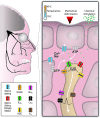Chemosensory properties of the trigeminal system
- PMID: 22778855
- PMCID: PMC3369707
- DOI: 10.1021/cn100102c
Chemosensory properties of the trigeminal system
Abstract
The capacity of cutaneous, including trigeminal endings, to detect chemicals is known as chemesthesis or cutaneous chemosensation. This sensory function involves the activation of nociceptor and thermoreceptor endings and has a protective or defensive function, as many of these substances are irritants or poisonous. However, humans have also developed a liking for the distinct sharpness or pungency of many foods, beverages, and spices following activation of the same sensory afferents. Our understanding of the cellular and molecular mechanisms of chemosensation in the trigeminal system has experienced enormous progress in the past decade, following the cloning and functional characterization of several ion channels activated by physical and chemical stimuli. This brief review attempts to summarize our current knowledge in this field, including a functional description of various sensory channels, especially TRP channels, involved in trigeminal chemosensitivy. Finally, some of these new findings are discussed in the context of the pathophysiology of trigeminal chemosensation, including pain, pruritus, migraine, cough, airway inflammation, and ophthalmic diseases.
Keywords: Chemestesis; KCNK; TRP channel; TRPA1; TRPM8; TRPV1; TRPV2; TRPV3; asthma; capsaicin; cough; dry eye; menthol; pain; pungency; spices.
Figures


References
-
- Fain G. L. (2003) Sensory Transduction, Sinauer Associates Inc., Sunderland, MA.
-
- Bryant B. P. and Silver W. L. (2000) in The Neurobiology of Taste and Smell (Finger T. E. and Silver W. L., Eds.), pp 73−100, Wiley-Liss, New York.
-
- Green B. G. (1996) Trends Food Sci. Technol. 7, 415–420.
-
- Parker G. H. (1912) J. Acad. Nat. Sci. 15, 221–234.
-
- Keele C. A. (1962) Arch. Int. Pharmacodyn. Ther. 139, 547–557. - PubMed
Publication types
MeSH terms
Substances
LinkOut - more resources
Full Text Sources
Other Literature Sources
Medical
Miscellaneous

